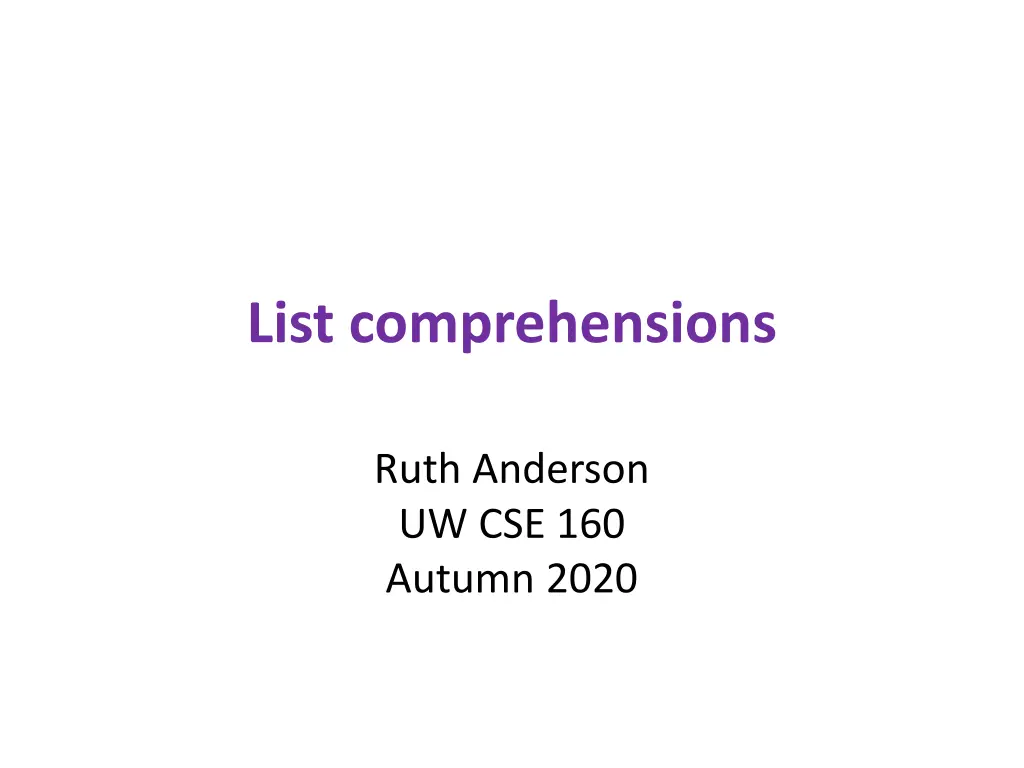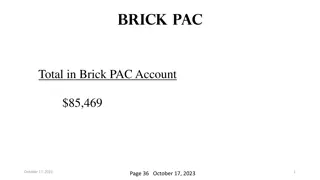
Python Comprehensions and Applications
Explore the power of list comprehensions in Python with examples covering different types of comprehensions like list, set, and dictionary. Learn how to efficiently manipulate data using comprehension techniques.
Download Presentation

Please find below an Image/Link to download the presentation.
The content on the website is provided AS IS for your information and personal use only. It may not be sold, licensed, or shared on other websites without obtaining consent from the author. If you encounter any issues during the download, it is possible that the publisher has removed the file from their server.
You are allowed to download the files provided on this website for personal or commercial use, subject to the condition that they are used lawfully. All files are the property of their respective owners.
The content on the website is provided AS IS for your information and personal use only. It may not be sold, licensed, or shared on other websites without obtaining consent from the author.
E N D
Presentation Transcript
List comprehensions Ruth Anderson UW CSE 160 Autumn 2020
Three Ways to Define a List squares = [0, 1, 4, 9, 16, 25, 36, 49, 64, 81, 100] Explicitly write out the whole thing: squares = [] for i in range(11): squares.append(i * i) Write a loop to create it: squares = [i * i for i in range(11)] Write a list comprehension: A list comprehension is a concise description of a list A list comprehension is shorthand for a loop
Two ways to convert Centigrade to Fahrenheit ctemps = [17.1, 22.3, 18.4, 19.1] With a loop: ftemps = [] for c in ctemps: f = celsius_to_farenheit(c) ftemps.append(f) With a list comprehension: ftemps = [celsius_to_farenheit(c) for c in ctemps] The comprehension is usually shorter, more readable, and more efficient
Syntax of a comprehension [(x, y) for x in seq1 for y in seq2 if sim(x, y) > threshold] expression for clause (required) assigns value to the variable x zero or more if clauses zero or more additional for clauses something that can be iterated
Semantics of a comprehension result = [(x, y) for x in seq1 for y in seq2 if sim(x, y) > threshold] result = [] for x in seq1: for y in seq2: if sim(x, y) > threshold: result.append((x, y)) useresult
Types of comprehensions List [i * 2 for i in range(3)] Set {i * 2 for i in range(3)} Dictionary { key: value for item in sequence } {i: i * 2 for i in range(3)}
Cubes of the first 10 natural numbers Goal: Produce: [0, 1, 8, 27, 64, 125, 216, 343, 512, 729] With a loop: cubes = [] for x in range(10): cubes.append(x ** 3) With a list comprehension: cubes = [x ** 3 for x in range(10)]
Powers of 2: ( 20 through 210 ) Goal: [1, 2, 4, 8, 16, 32, 64, 128, 256, 512, 1024] powers = [2 ** i for i in range(11)]
Lengths of elements of a list Goal: Write a list comprehension that computes the length of each string in the list colors. colors = ["red", "blue", "purple", "gold", "orange"] lengths = [**your expression goes here**] [3, 4, 6, 4, 6]
Even elements of a list Goal: Given an input list nums, produce a list of the even numbers in nums nums = [3, 1, 4, 1, 5, 9, 2, 6, 5] evens = [**your expression goes here**] [4, 2, 6]
Dictionary of squares Goal: Given an input list nums, produce a dictionary that maps each number to the square of that number. nums = [3, 1, 4, 5, 9, 2, 6, 7] square_dict = {**your expression goes here**}
Normalize a list num_list = [6, 4, 2, 8, 9, 10, 3, 2, 1, 3] total = sum(num_list) With a loop: for i in range(len(num_list)): num_list[i] = num_list[i] / total With a list comprehension: num_list = [num / total for num in num_list]
Dice Rolls Goal: A list of all possible dice rolls. With a loop: rolls = [] for r1 in range(1, 7): for r2 in range(1, 7): rolls.append((r1, r2)) With a list comprehension: rolls = [(r1, r2) for r1 in range(1, 7) for r2 in range(1, 7)]
All above-average 2-die rolls Goal: Result list should be a list of 2-tuples: [(2, 6), (3, 5), (3, 6), (4, 4), (4, 5), (4, 6), (5, 3), (5, 4), (5, 5), (5, 6), (6, 2), (6, 3), (6, 4), (6, 5), (6, 6)] [(r1, r2) for r1 in range(1, 7) for r2 in range(1, 7) if r1 + r2 > 7] OR [(r1, r2) for r1 in range(1, 7) for r2 in range(8 - r1, 7)]
Sum of above-average 2-die rolls Goal: Result list should be a list of integers: [r1 + r2 for r1 in range(1, 7) for r2 in range(1, 7) if r1 + r2 > 7] [8, 8, 9, 8, 9, 10, 8, 9, 10, 11, 8, 9, 10, 11, 12] Remove Duplicates: Use Set Comprehensions {r1 + r2 for r1 in range(1, 7) for r2 in range(1, 7) if r1 + r2 > 7} {8, 9, 10, 11, 12}
Making a Grid Goal: A grid were each element is the sum of it's row # and column #. (e.g. [[0, 1, 2], [1, 2, 3]]) With a loop: grid = [] for i in range(2): row = [] for j in range(3): row.append(i + j) grid.append(row) With a list comprehension: grid = [[i + j for j in range(3)] for i in range(2)]
A word of caution List comprehensions are great, but they can get confusing. Err on the side of readability. nums = [n for n in range(100) if sum([int(j) for j in str(n)]) % 7 == 0] or nums = [] for n in range(100): digit_sum = sum([int(j) for j in str(n)]) if digit_sum % 7 == 0: nums.append(n)
A word of caution List comprehensions are great, but they can get confusing. Err on the side of readability. nums = [n for n in range(100) if sum([int(j) for j in str(n)]) % 7 == 0] or def sum_digits(n): digit_list = [int(i) for i in str(n)] return sum(digit_list) nums = [n for n in range(100) if sum_digits(n) % 7 == 0]






















